
A role-playing game is a game in which players assume the roles of characters in a fictional setting. Players take responsibility for acting out these roles within a narrative, either through literal acting or through a process of structured decision-making regarding character development. Actions taken within many games succeed or fail according to a formal system of rules and guidelines.
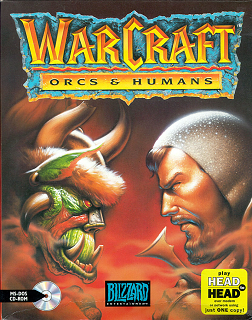
Warcraft: Orcs & Humans is a real-time strategy game (RTS) developed and published by Blizzard Entertainment, and published by Interplay Productions in Europe. It was released for MS-DOS in North America on 15 November 1994, and for Mac OS in early 1996. The MS-DOS version was re-released by Sold-Out Software in 2002.

World of Warcraft (WoW) is a massively multiplayer online role-playing game (MMORPG) released in 2004 by Blizzard Entertainment. Set in the Warcraft fantasy universe, World of Warcraft takes place within the world of Azeroth, approximately four years after the events of the previous game in the series, Warcraft III: The Frozen Throne. The game was announced in 2001, and was released for the 10th anniversary of the Warcraft franchise on November 23, 2004. Since launch, World of Warcraft has had nine major expansion packs: The Burning Crusade (2007), Wrath of the Lich King (2008), Cataclysm (2010), Mists of Pandaria (2012), Warlords of Draenor (2014), Legion (2016), Battle for Azeroth (2018), Shadowlands (2020), and Dragonflight (2022). Three further expansions, The War Within (2024), Midnight, and The Last Titan, were announced in 2023.
Warcraft is a franchise of video games, novels, and other media created by Blizzard Entertainment. The series is made up of six core games: Warcraft: Orcs & Humans, Warcraft II: Tides of Darkness, Warcraft III: Reign of Chaos, World of Warcraft, Hearthstone, and Warcraft Rumble. The first three of these core games are in the real-time strategy genre, where opposing players command virtual armies in battle against each other or a computer-controlled enemy. The fourth and best-selling title of the franchise is a massively multiplayer online role-playing game (MMORPG), where players control their character and interact with each other in a virtual world.

Warcraft Adventures: Lord of the Clans is a cancelled graphic adventure game developed by Blizzard Entertainment and Animation Magic from 1996 until 1998. Set in the Warcraft universe after the events of Warcraft II: Beyond the Dark Portal, it followed the orc character Thrall in his quest to reunite his race, then living on reservations and in slavery following its defeat by the human Alliance. Assuming the role of Thrall, the player would have used a point-and-click interface to explore the world, solve puzzles and interact with characters from the wider Warcraft series.
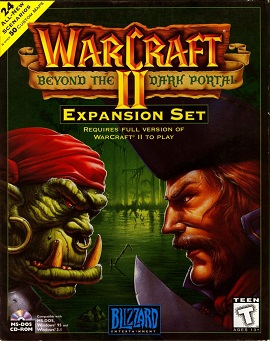
Warcraft II: Beyond the Dark Portal is an expansion pack for the real-time strategy video game Warcraft II: Tides of Darkness for MS-DOS, Microsoft Windows and Macintosh. It was developed by Blizzard Entertainment and Cyberlore Studios, and published by Blizzard in North America and Europe in 1996. It requires the full version of the original game to run and adds new story campaigns and multiplayer maps. The expansion was later released alongside Tides of Darkness for the PlayStation and Sega Saturn in 1997 as Warcraft II: The Dark Saga, and was included in the Warcraft II: Battle.net Edition for Windows PC and Macintosh in 1999.

World of Warcraft: The Burning Crusade is the first expansion set for the MMORPG World of Warcraft. It was released on January 16, 2007 at local midnight in Europe and North America, selling nearly 2.4 million copies on release day alone and making it, at the time, the fastest-selling PC game released at that point. Approximately 3.53 million copies were sold in the first month of release, including 1.9 million in North America, nearly 1.6 million in Europe, and over 100,000 copies in Australia.

The Corrupted Blood incident took place between September 13 and October 8, 2005, in World of Warcraft, a massively multiplayer online role-playing game (MMORPG) developed by Blizzard Entertainment. When participating in a certain boss battle at the end of a raid, player characters would become infected with a debuff that was transmitted between characters in close proximity. While developers intended to keep the effects of the debuff within this boss's game region, a programming oversight soon led to an in-game pandemic throughout the fictional world of Azeroth.
EN World, also known as Morrus' Unofficial Tabletop RPG News, is a British-owned tabletop role-playing game news and reviews website. The website is run and owned by Russ Morrissey ("Morrus"). It reports current news and provides insight into major product releases before they are officially unveiled. EN World was the original host of the ENNIE Awards.
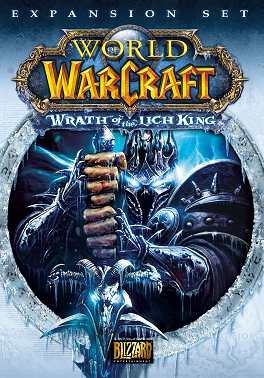
World of Warcraft: Wrath of the Lich King is the second expansion set for the massively multiplayer online role-playing game (MMORPG) World of Warcraft, following The Burning Crusade. It launched on November 13, 2008 and sold 2.8 million copies within the first day, making it the fastest selling computer game of all time released at that point. The game added a substantial amount of new content into the game world, including the new continent of Northrend, home of The Lich King Arthas and his undead minions. In order to advance through Northrend, players were required to reach at least level 68, with the level cap for the expansion being 80. The first hero class was introduced, the Death Knight, that starts at level 55.
World of Warcraft, or WoW, is set in a fictional universe, its primary setting being the planet of Azeroth. The first expansion, The Burning Crusade, introduced a second planet, Outland. Wrath of the Lich King and Cataclysm expanded upon Azeroth and respectively added Northrend, the frigid northern continent of Azeroth, and drastically changed various other continents by destroying some and unveiling new ones. The next expansion, Mists of Pandaria, added Pandaria, the southern continent previously hidden behind a perennial mist cover. Warlords of Draenor introduced the planet of Draenor, a version of Outland in a different timeline before its partial destruction. The Legion expansion took adventurers to the Broken Isles, an island chain near the Maelstrom in the middle of the Great Sea, and the damaged planet Argus, the headquarters of the Burning Legion. The seventh expansion, Battle for Azeroth, added two new island continents to the center of Azeroth: Kul Tiras and Zandalar. The latest expansion, Shadowlands, introduced the eponymous Shadowlands, a realm composed of five major zones: Bastion, Maldraxxus, Ardenweald, Revendreth, and the Maw.
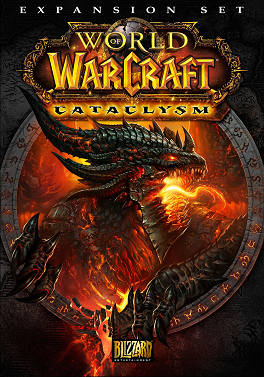
World of Warcraft: Cataclysm is the third expansion set for the massively multiplayer online role-playing game (MMORPG) World of Warcraft, following Wrath of the Lich King. It was officially announced at BlizzCon on August 21, 2009, although dataminers and researchers discovered details before it was announced by Blizzard. The expansion was released on December 7, 2010.

World of Warcraft: Warlords of Draenor is the fifth expansion set to the massively multiplayer online role-playing game (MMORPG) World of Warcraft, following Mists of Pandaria. It was announced on November 8, 2013 at BlizzCon 2013. The expansion was released on November 13, 2014.

Powered by the Apocalypse (PbtA) is a tabletop role playing game design framework developed by Meguey Baker and Vincent Baker for the 2010 game Apocalypse World and later adapted for hundreds of other RPGs.
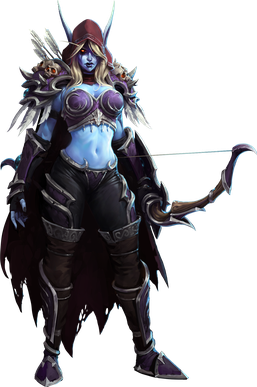
Sylvanas Windrunner is a fictional character who appears in the Warcraft series of video games by Blizzard Entertainment. Originally introduced in Warcraft III: Reign of Chaos, she received a dramatic redesign in World of Warcraft: Wrath of the Lich King, followed by a minor redesign in World of Warcraft: Legion. Once a high elf ranger-general of Silvermoon, Sylvanas was murdered by Arthas Menethil when she led a doomed resistance against his invasion. In one climactic battle, that left the capital city of Silvermoon in ruins, he managed to finally beat the elven general, ripping her soul out and transforming her into a banshee. This newest agent of the Lich King was empowered by hatred of the living and an everlasting desire to rule over her new people. In The Frozen Throne, Sylvanas was able to regain her free will and body, and founded the Forsaken faction of undead while styling herself as the "Banshee Queen" and "Dark Lady". With her new undead forces vowing to take revenge on the Lich King, they set out to wage war against the Scourge. Throughout nearly the entirety of Legion and the first one-third of Battle for Azeroth, she was also the Warchief of the Horde, standing as one of the most powerful political leaders in all of Azeroth following the death of Vol'jin during the opening events of Legion. She effectively abandoned the role in patch 9.1, Chains of Domination, resulting in the title of Warchief being retired and replaced by the Horde Council while leadership of the Forsaken is inherited by Desolate Council.
Shannon Appelcline is a game designer and game historian.

World of Warcraft: Battle for Azeroth is the seventh expansion pack for the massively multiplayer online role-playing game (MMORPG) World of Warcraft, following Legion. It was announced at BlizzCon on November 3, 2017. In contrast to previous expansions, which went live at midnight in each time zone, Battle for Azeroth had a simultaneous release for all regions, corresponding to midnight Central European Summer Time on August 14, 2018.

World of Warcraft: Shadowlands is the eighth expansion pack for the massively multiplayer online role-playing game (MMORPG) World of Warcraft, following Battle for Azeroth. It was announced and made available for preorder at BlizzCon on November 1, 2019. Originally scheduled for release on October 27, 2020, its release was delayed until November 23, the sixteenth anniversary of the original game's release.
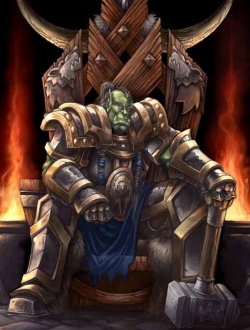
Thrall, born as Go'el, is a fictional character who appears in the Warcraft series of video games by Blizzard Entertainment. Within the series, Thrall is an orc shaman who served for a time as a Warchief of the Horde, one of the major factions of the Warcraft universe, as well as the leader of a shaman faction dedicated to preserving the balance between elemental forces in the world of Azeroth known as the Earthen Ring. Originally introduced in promotional material released by Blizzard Entertainment as the protagonist of the canceled video game Warcraft Adventures: Lord of the Clans, which was co-developed by Blizzard and Animation Magic from 1996 until 1998, Thrall's first proper appearance is in the 2001 novelization of the canceled video game's narrative authored by American novelist Christie Golden. The novel's story is set during his youth, where he is depicted as a slave who was raised by an abusive human military officer, but eventually rebelled and escaped captivity.

The dracthyr are a fictional race of anthropomorphic dragons in the Warcraft franchise. They were introduced as a playable race in the 2022 World of Warcraft expansion, Dragonflight, with the only class available being the Evoker, a caster that utilizes magic from the five dragonflights to heal allies, deal damage, or provide buffs. Unlike the game's other races, they are capable of flight and aerial combat. While they are primarily draconic, they can switch freely to a magical humanoid "visage" form if they choose. They were praised by critics for the drastic gameplay changes they added to the game, and were seen as significantly modernizing an otherwise dated title. However, they were criticized for a lack of customization while in dragon form, with most armors looking similar without turning back into a human.
















